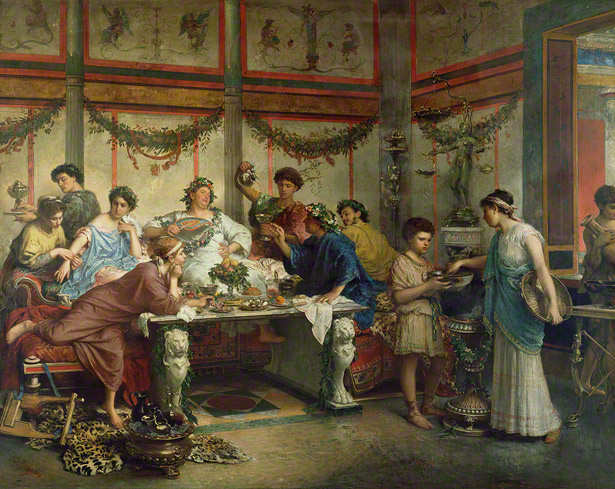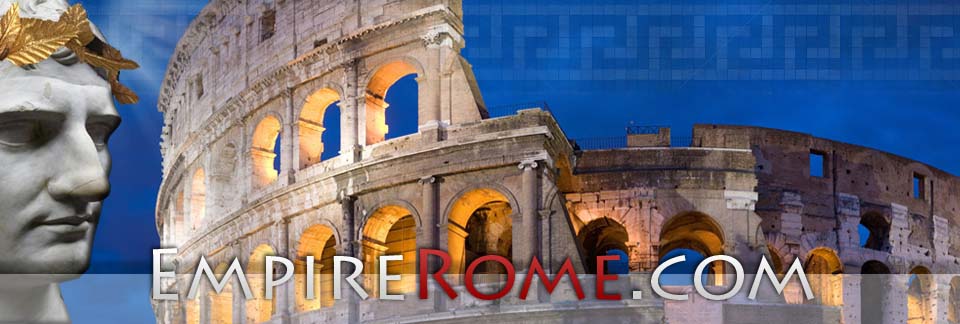
Breakfast (ientaculum or jentaculum)
| Served: | Early morning or dawn before sunrise. |
| Portion size: | Quick food that was small in portion because Romans were not big on breakfast. |
| Consisted of: | Mostly it was some type of bread dipped in wine. However, Romans did eat various: meats, fresh & dried fruit, honey, vegetables, eggs, cheese, milk, and bread dipped in wine. |
Breakfast in ancient Rome was not a major meal. Most Romans ate their breakfast on the run before they started their daily activities. Roman breakfast was called the ientaculum or jentaculum. It was eaten at dawn or sunrise and was not a family meal due to its lack of importance. Breakfast in ancient Rome manly consisted of some bread, fruit, cheese, and some watered down wine to wash it down. Breakfast was much simpler if you were a slave or poor person. It would have been limited to bread, porridge only, or maybe a piece of fruit.
Lunch (cibus meridianus or prandium)
| Served: | Early afternoon |
| Portion size: | Small portion to hold them until dinner; usually a quick meal. This name prandium was not used until the later part of the Roman empire. For the wealthy and elite it would be a cold lunch and for the common folk it would be the main meal. |
| Consisted of: | Various meats, salted bread, eggs, vegetables, cheese, and salad. |
Lunch in ancient Rome meant different things depending on if you were wealthy or common folk. For the elite and wealthy of ancient Rome, lunch mainly consisted of light food. The wealthy used this meal to hold them until the cena started. The common folk or labor workers used this meal as their main meal. Depending on which class you belonged to this was your final main meal. After this meal, poor roman citizens would have not eaten much after this as food was expensive. This meal for the common folks generally consisted of one dish as they lacked the means for a cena which was a massive late afternoon meal which is discussed further in this article.
Light Dinner (vesperna)
| Served: | Late afternoon or sundown. |
| Portion size: | Light supper with small portions that was phased out once the cena became more self-indulgent with heavier and more lavish foods. The Lunch time meal (cibus meridianus or prandium) took the place of the vesperna as this meal is in the afternoon. This meal was still the ordinary meal for common people throughout ancient Rome till the end of the empire. Not everyone could afford the cena as it was usually held by wealthy people in ancient Rome. |
| Consisted of: | One dish meal which consisted of a meatless dish. If meat was added, they would have called it a cena. Meat was only added for special occasions like holidays or religious festivals. |
The light dinner also known as the vesperna was the meal for all early ancient Romans. It would soon be replaced with a bigger meal as Rome grew in power and decadence. This meal was also the evening meal for common citizens throughout the Roman Empire. The vesperna meal was also the standard dinner meal until the empire perished for people of low status in Roman society and who could not afford the famous cena meal. The cena meal was most commonly associated with Rome due to its lavish style of eating. Additionally, this meal lacked meat and proteins and would have been very simple by Roman standards as varieties of foods cost money. Most of these meals only consisted of one dish unless there was a celebration of some kind. In the event of a celebration due to a holiday or special event, it was upgraded to a limited cena. A cena meal was as decadent as the people who threw them. This means a poor person in the Roman Empire would have a less extravagant cena while the wealthy would have huge elaborate cena meal with multiple courses.
Dinner (cena)
| Served: | Late afternoon after daily activities were done and lasted until the late night hours. Guest and entertainment would be present at this main meal. |
| Portion size: | Main meal of the day with multiple courses and large portions. Watered down wine was standard drink for ancient Romans. This is the meal most people will likely learn about in ancient Rome. |
| Consisted of: | Elaborate for upper classes and simpler for the labor workers and common people. People ate: vegetables, eggs, cheese, honey, fruits, and various meats.This meal took on different styles and courses as the Roman empire became richer and more powerful.
Gustatio, promulsis or antecoena – appetizer course usually consisted of eggs or salad. Primae mensae – Main course; varied among the classes. It could also be broken into three main parts: cena prima, cena secunda, and cena tertia. Secundae mensae – Dessert consisted mainly of fruit, honey and seafood. Comissatio – Final wine course at dinner’s end. |
Dinner in ancient Rome for the wealthy and elite was a big deal. This main meal of the day started midday and lasted until the late hours of the night. This meal evolved from the prandium and shifted to the evening for the wealthy which became known as the cena. Many Romans used to invite their friends and family to this meal as it was an excuse to socialize and have elaborate parties. These parties would have rich entertainment and dishes that delighted the people who attended them. Cena dinners were different depending on your wealth and social status.
In early Rome the cena basically consisted of porridge. It was made from emmer, salt, fat, and water. These porridges changed with wealthy eaters. The more sophisticated ones were made of vegetables and olive oil.
Unlike the other two meals which did not have a huge emphasis on wealthy Roman society; the elite reclined on their sides and ate until their hearts content. Wealthy ancient Romans did not like to sit on chairs and use a table as this was uncomfortable for them. Stools were reserved for the much lower class. Children who attended these elaborate dinners would generally sit on stools. The table in ancient Rome was much smaller and used as resting places for food and not like today where we would all sit around it and eat our food. It should be noted that only adults got to recline on couches and eat in that relaxed style which ancient Rome was known for.
The cena meal was broken up into 3 major different parts. It had an appetizer, main course, dessert, and final wine course at dinners end. As stated earlier, it varied depending on wealth. See below for a detailed explanation of each part of the main meal.
The appetizer also known as the gustatio, promulsis or antecoena was part of the meal which usually involved different eggs cooked in various ways. Usually they were slightly cooked and left mostly raw or poached. An example of a famous dish is hen’s eggs poached in red wine with a raw yoke and eaten before the main course. Another appetizer was the salad that was mixed with local greens.
The main course varied in ancient Roman society depending on wealth and social status. Depending on the wealth of the person serving the main meal, it could be further broken down into three additional parts. They usually consisted of 3 or more courses and were all numbered to keep track of which meal was being eaten. Most main courses did not consist of any meat as this type of food was for the extremely wealthy. Meat was used for special occasions and events. When the rich served meat, they had to be careful how frequent they had it otherwise they would be mocked. Having too much meat was considered a display of economic power and not looked highly in ancient Rome.
Dessert also known as the secunda mensa was at the end of the meal and consisted of fruit and honey or cheese cake. Unlike today, ancient Romans did not have refined sugar or butter. Most of the popular desserts in that time consisted of honeyed wine and dried and fresh fruits mixed with honey to enhance sweetness. Puddings and cheesecakes were also served however they were not as poplar and not like modern desserts of today.
Today we would not consider these desserts in modern times, but olives, chickpeas, oysters, shell fish, and shrimp were considered dessert and eaten frequently. Olives and chickpeas were placed on fruit trays and oysters and various shell fish were eaten fresh cold and raw straight out of the shell and were believed to help digestion after dinner.
That last part of the dinner was called the comissatio which was basically a round of drinks. This was also known as the final course of dinner.

